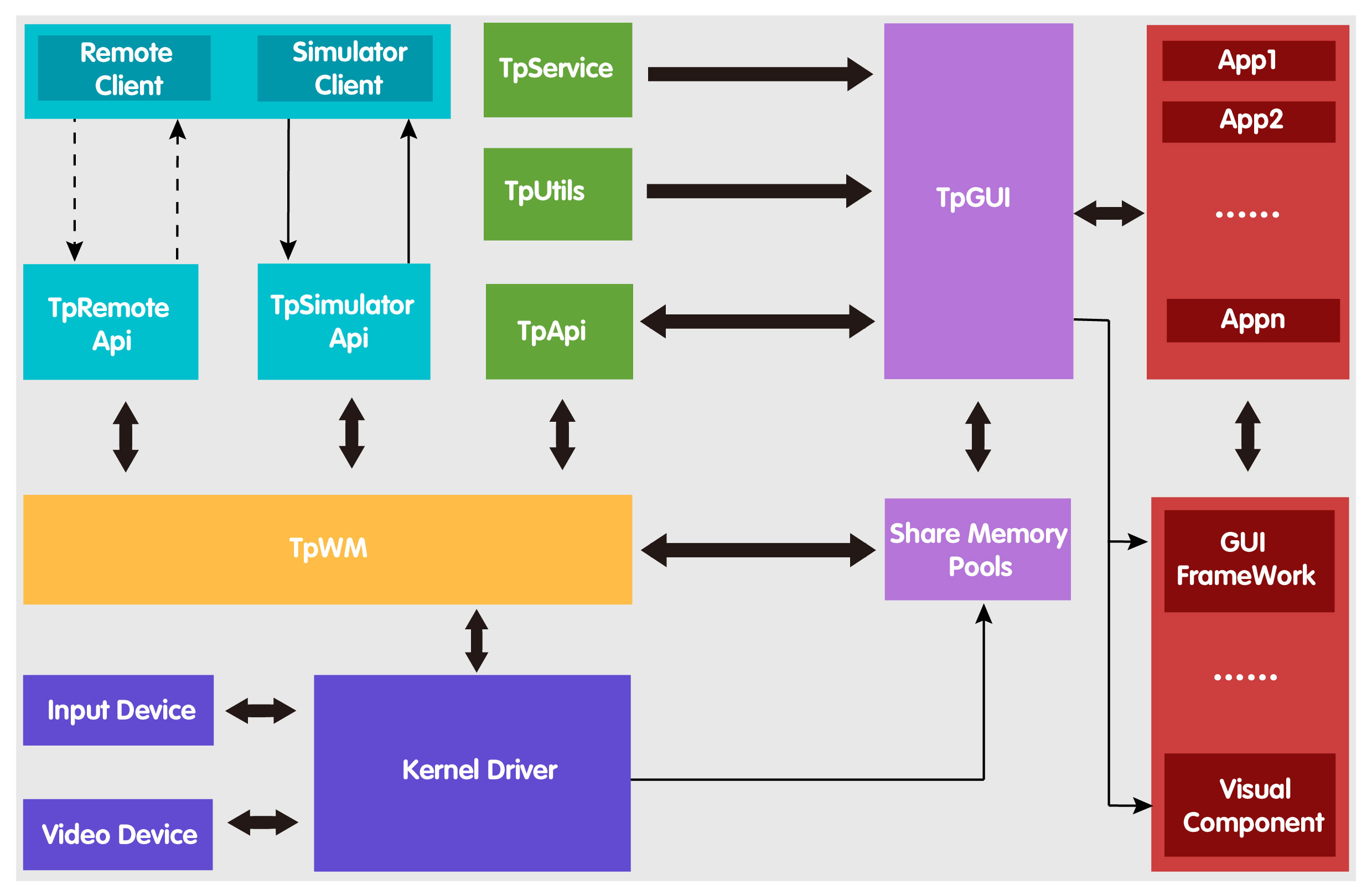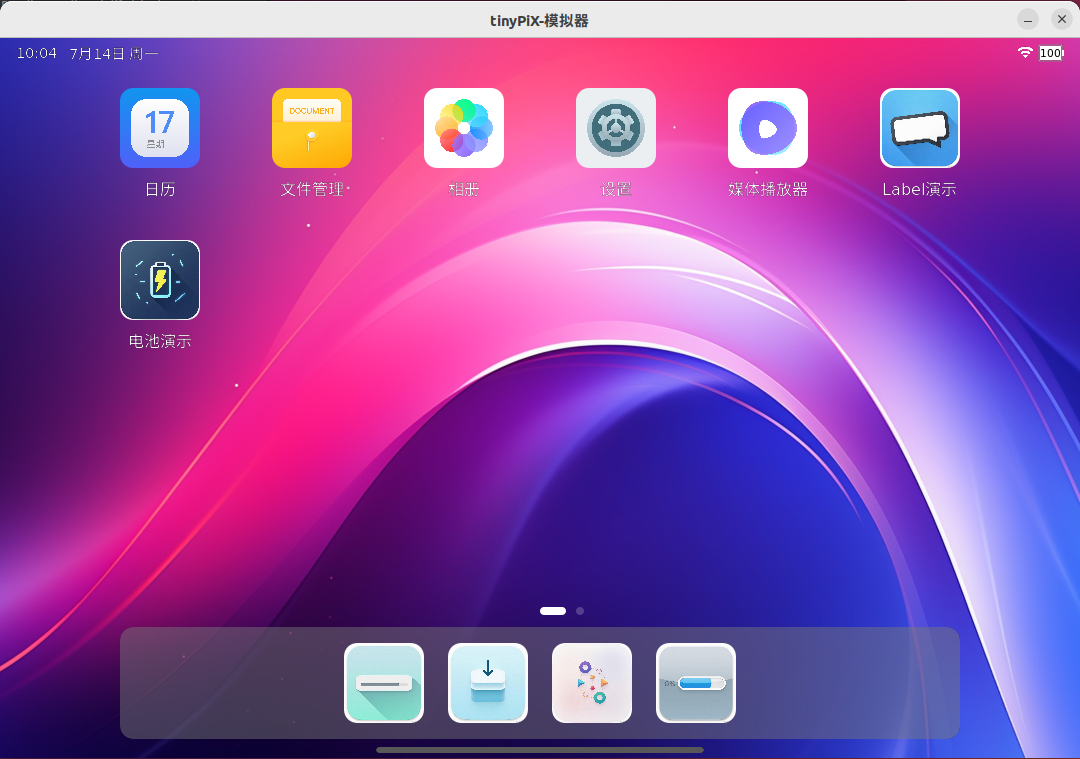TinyPiXOS
About 1489 wordsAbout 5 min
2025-07-17
Origin of the TinyPiXOS Name
TinyPiXOS (also known as PiXOS; Chinese name: Pi OS; the prefix Tiny highlights its lightweight design) reflects our technical philosophy and product vision.
Learn more
Tiny · Lightweight Core
“Tiny” points to the core: a lightweight desktop operating system crafted for resource-constrained embedded environments.Pi · Enduring Foundation
“Pi” comes from the mathematical constant π, representing enduring stability, operational reliability, and universal compatibility—aiming to be a solid foundation for embedded devices.X · Infinite Future
“X” symbolizes the unknown and expansion, implying boundless extensibility and future possibilities—encouraging developers to explore and create freely on this platform.PiX · The World of Graphics
“PiX” naturally combines Pi and X, cleverly echoing the word “Pixel”. The system provides capabilities of a modern graphical desktop environment.Chinese “Pi” · Openness and Co-creation
The Chinese name “派 (Pi)” is a transliteration of “Pi” and embodies the dual vision of open sharing and forming an independent school of thought. We aim to build an open, sharing developer community.
In summary, TinyPiXOS (Pi OS) strives to be a stable, open, and user-friendly lightweight embedded operating system with a modern graphical interface, providing developers with an innovation platform full of possibilities.
System Overview
TinyPiXOS is built on open-source Linux. Through innovative kernel-level lightweight adaptations and streamlined design, it dispenses with traditional X11/Wayland graphics stacks, rebuilding an ultra-lightweight end-to-end graphics technology stack in pure C/C++—including efficient window management, a streamlined GUI framework, and deeply optimized kernel mechanisms.
TinyPiXOS marks our journey from zero to a fully self-controlled foundational technology stack. Its core positioning is to provide a lightweight, highly customizable, and independently controllable development platform for embedded desktop operating systems.
Core Objective: Under minimal hardware resource budgets, ensure smooth parallel processing of multiple applications and deliver a complete desktop-class core feature experience
System Advantages
- Autonomous & Controllable: Self-developed TpWM window manager and GUI framework;
no dependency on X11/Wayland. - Lightweight & Flexible: Modular architecture for on-demand tailoring, optimized memory and process scheduling, maximal resource utilization; deployable from tiny embedded devices to high-performance mobile terminals.
- Heterogeneous Compatibility: Unified C/C++ development interfaces with seamless migration across ARM/x86/RISC-V.
- Ready to Use: Prebuilt UI component library for quickly starting application development.
- Long-term Maintenance: The technical team provides sustained maintenance so progress isn’t blocked by issues.
- Chinese Support: Friendly support for Chinese text within the system.
- Free for Commercial Use: Free for commercial use (copyright notice required); enables low-cost, customized systems to speed product launch.
Why Build a New “Wheel”?
Guided by the “indigenous innovation” strategy, domestic operating systems are rapidly building an end-to-end autonomous and controllable ecosystem from chips to software. Representative systems such as Kylin V10 and HarmonyOS rely on open-source collaboration and independent IP to gradually replace Windows and Android. The next-generation digital office white paper indicates that integrating domestic hardware and software ecosystems is key to data security. Aside from HarmonyOS covering mobile, most domestic OS efforts focus on PC desktops, leaving embedded mobile device desktop operating systems relatively underserved.
To fill this gap, the TinyPiXOS technical team aims to leverage its expertise to independently develop a lightweight desktop operating system for mobile devices. The goal is to spark broader innovation and drive the diversification of the domestic OS ecosystem, ultimately achieving a vibrant “hundred schools of thought” landscape.
What Have We Built?
Core Modules (Self-Developed)
To achieve end-to-end autonomy and control, we self-developed TinyPiXOS core modules:

GUI Desktop Interaction Design and DevelopmentDemo System
To validate core module functionality, we designed and developed a desktop interaction sample system based on our self-developed modules. It initially implements desktop interaction, multi-application management, application installation/uninstallation, etc., enabling developers to extend and build their own desktop OS on this foundation.
We referenced mainstream desktop application packaging specifications and initially defined TinyPiXOS packaging requirements. Applications initially developed include [System Desktop], [Multi-App Manager], [File Manager], [Media Player], [System Input Method], and [Settings] (framework completed). Sample Applications

Use Cases
TinyPiXOS is a comprehensive OS for lightweight embedded mobile terminals (e.g., smartphones, tablets, portable industrial devices). Its core characteristics come from the deep integration of an embedded architecture with lightweight design—maximizing hardware efficiency while delivering a full desktop interaction experience. Suitable scenarios include:
- Customized mobile device OS (smart terminals/industrial tablets)
- Cloud desktop virtualized display terminals
- Industrial control platform HMI (human–machine interface)
- In-vehicle infotainment systems (IVI)
- IoT hub control terminals (smart home gateways/edge nodes)
Tips
More scenarios are continuously expanding… (We open architecture docs for ecosystem validation)
(More scenarios waiting to be unlocked…)
Open-Source Project
TinyPiXOS allows personal and enterprise free commercial use under the Apache 2.0 license, with UI attribution retained.
About TinyPiXOS Developer Alliance
A domestic technical community focused on autonomous and controllable embedded desktop OS development, covering the complete OS technology stack.

✅ Complete Technical Architecture
Window Manager: TpWM, a lightweight window manager implemented in pure C, replacing traditional X11/WaylandGUI Framework: TpGUI, a complete graphical UI solutionSystem Integration: TpExtUtils provides HALs for Bluetooth, networking, multimedia, and storageCore Toolchain: TpUtils foundation library covering data serialization, file operations, and communication mechanismsApplication Ecosystem: TinyPiXApp application framework providing a complete solution for app development
✅ Multi-language Technology Stack
C System Programming: Master TpWM internals, system calls, and memory managementC++ OOP: Proficient in TpGUI design, modern C++11, and design patternsCross-Platform Build: Supports x86_64/ARM64; master cross-compilation techniques
✅ Personal Growth
Systems Architect: End-to-end system design from window management to application frameworksEmbedded Full-Stack: Develop across tiny devices to high-performance mobile terminalsGUI Programming: Event-driven architecture, rendering optimizations, styling systemsHAL Development: Display management, device monitoring, Bluetooth communication drivers
✅ Capability Enhancement
OS Kernel: Deeply understand Linux kernel mechanisms; master lightweight adaptationsWindow System: Learn modern window manager design principles and implementation techniquesApplication Framework: Build scalable, high-performance application frameworksOpen Source Contribution: Contribute to related projects; improve code quality and collaboration
✅ Learning Outcomes
By systematically learning the full TinyPiXOS technology stack, you will gain comprehensive operating-system development capabilities—from low-level window management to upper-layer application development—making the leap from application developer to systems architect. We provide a stepwise advancement path, with cross-disciplinary expert guidance to help you build a multidimensional capability matrix.
Please Follow and Star to Support the Project
Scan the QR code or click a link

Scan the QR code to follow the WeChat public account
视频介绍
Copyright
Copyright Ownership:TinyPiXOS
License under:Attribution-ShareAlike 4.0 International (CC-BY-SA-4.0)

